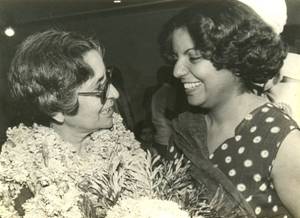|
The Original Lahoran Nirupama Dutt
here do you come from? This is a question we all have to answer only too often. It is the place a person belongs to that decides many things. For the likes of me born after Partition of the country to parents who migrated from West Punjab, the problem of roots and identity has always been a complex one. My usual answer to this question would be, "I come from Chandigarh." Now that Chandigarh has completed fifty years of existence, the reply is accepted but some two and a half decades ago I remember the Punjabi writer Kulwant Singh Virk getting vexed at this reply and saying, "No one can belong to Chandigarh. Tell me where your parents were from?" When I told him that my mother was from Rawalpindi, my father from Lahore and I from Chandigarh, he laughed and said, "So you are the daughter of three Capitals."
Nirupama Dutt with Amrita Pritam. Jalandhar. 1983 My name on the other hand causes more identity crises. The suffix of 'Dutt' often raises doubts about my lingual affiliations. With a Bengali-sounding first name that my mother took most probably from one of the Sarat Chandra novels that she devoured in her youth, and named her children Arvind, Vimal, Salil and so on. With my dark looks highlighting my name, I have often been taken for a Bengali. Well, this has been help at times and more so in my career as an art critic. A Bengali name gets an easier entry in culture-land where the pragmatic Punjabis are most often 'agriculturally' suspect. So very often I let this case of mistaken identity pass but when I break into Punjabi verse, I have had surprised bhadralok raising an eyebrow. Other times I have to tell enthusiastic young artists from Kolkatta who roll the 'a' present twice in my first name into round ‘roshogullas’, add Didi and rattle off in Bangla, that I am a Punjabi. "How come?" follows the surprised query, "Dutts are Bengalis." I tell them that they are Punjabis too and to convince them, I say, "The Sunil Dutt variety." He is the most famous among the Punjabi Dutts. However in a sojourn to Lahore this month, I learnt a lot more about the Dutts, who belong to a clan popularly known as Hussaini Brahmins. Their mythical origin is traced to Dronacharya of the Eklavya thumb infamy. But in history they redeemed themselves by denouncing Brahmanical practices and becoming warriors and agriculturalists. In 681 A.D. Rahab Sidh Dutt fought for the sons of Prophet Mohammad in Karbala and sacrificed seven of his sons in battle on the tenth day of the Moharram. Overwhelmed by grief Rahab and his kith and kin returned to their roots in Punjab and settled down in Lahore. The Muslims remained grateful to them for their sacrifices in Karbala and they were never forced to change their religion. The famous saying about them goes thus Wah Dutt Sultan, Hindu ka dharma, Musalman ka iman, Wah Dutt Sultan, Adha Hindu, adha Musalman. Majid Sheikh in an article on the Dutts of Mochi Gate (Dawn January 6, 2004) writes that they lived in large numbers in Lahore and fled the city only at the time of Partition. The writer also mentions that Sunil Dutt gifted $100,000 to Shaukat Khanum Cancer Hospital in the memory of his wife, the celebrated actress Nargis. Sheikh records with joy the statement of Sunil Dutt that accompanied the donation. "For Lahore, a Dutt will even give his life." The Dutts had put up a brave resistance to Mahmood of Ghazni in Lahore. Sheikh says in his article that the Dutts along with Manjs and Virks were among the original Lahoris. Dutts may have done something for Lahore but it is Lahore that his given me the identity of being an original Lahoran.
|
|||
